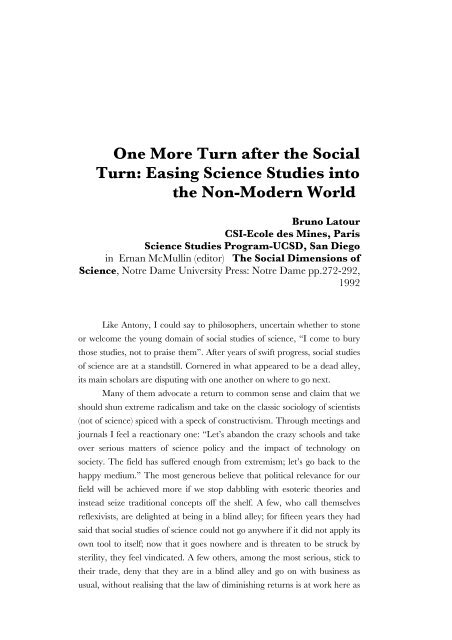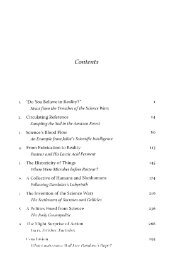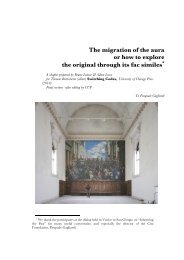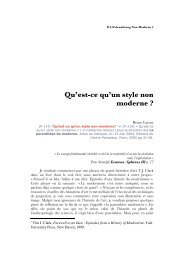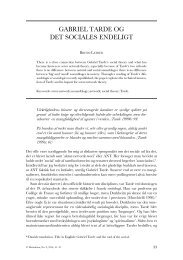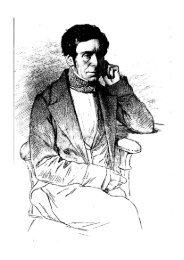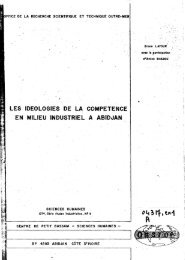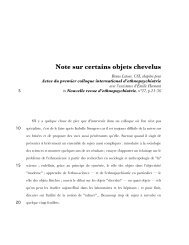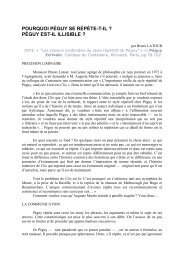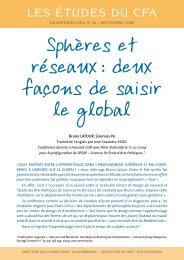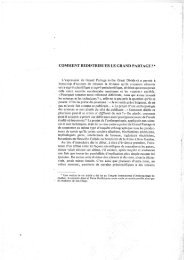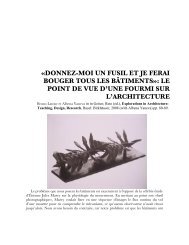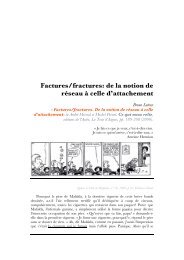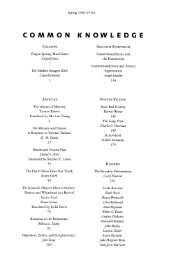One More Turn after the Social Turn: Easing Science ... - Bruno Latour
One More Turn after the Social Turn: Easing Science ... - Bruno Latour
One More Turn after the Social Turn: Easing Science ... - Bruno Latour
You also want an ePaper? Increase the reach of your titles
YUMPU automatically turns print PDFs into web optimized ePapers that Google loves.
<strong>One</strong> <strong>More</strong> <strong>Turn</strong> <strong>after</strong> <strong>the</strong> <strong>Social</strong><br />
<strong>Turn</strong>: <strong>Easing</strong> <strong>Science</strong> Studies into<br />
<strong>the</strong> Non-Modern World<br />
<strong>Bruno</strong> <strong>Latour</strong><br />
CSI-Ecole des Mines, Paris<br />
<strong>Science</strong> Studies Program-UCSD, San Diego<br />
in Ernan McMullin (editor) The <strong>Social</strong> Dimensions of<br />
<strong>Science</strong>, Notre Dame University Press: Notre Dame pp.272-292,<br />
1992<br />
Like Antony, I could say to philosophers, uncertain whe<strong>the</strong>r to stone<br />
or welcome <strong>the</strong> young domain of social studies of science, “I come to bury<br />
those studies, not to praise <strong>the</strong>m”. After years of swift progress, social studies<br />
of science are at a standstill. Cornered in what appeared to be a dead alley,<br />
its main scholars are disputing with one ano<strong>the</strong>r on where to go next.<br />
Many of <strong>the</strong>m advocate a return to common sense and claim that we<br />
should shun extreme radicalism and take on <strong>the</strong> classic sociology of scientists<br />
(not of science) spiced with a speck of constructivism. Through meetings and<br />
journals I feel a reactionary one: “Let’s abandon <strong>the</strong> crazy schools and take<br />
over serious matters of science policy and <strong>the</strong> impact of technology on<br />
society. The field has suffered enough from extremism; let’s go back to <strong>the</strong><br />
happy medium.” The most generous believe that political relevance for our<br />
field will be achieved more if we stop dabbling with esoteric <strong>the</strong>ories and<br />
instead seize traditional concepts off <strong>the</strong> shelf. A few, who call <strong>the</strong>mselves<br />
reflexivists, are delighted at being in a blind alley; for fifteen years <strong>the</strong>y had<br />
said that social studies of science could not go anywhere if it did not apply its<br />
own tool to itself; now that it goes nowhere and is threaten to be struck by<br />
sterility, <strong>the</strong>y feel vindicated. A few o<strong>the</strong>rs, among <strong>the</strong> most serious, stick to<br />
<strong>the</strong>ir trade, deny that <strong>the</strong>y are in a blind alley and go on with business as<br />
usual, without realising that <strong>the</strong> law of diminishing returns is at work here as
48-ONE MORE TUREN-GB 2<br />
elsewhere and that professional loyalties are no guarantee against<br />
obsolescence. But, fortunately, dozens of researchers are looking for ways out<br />
of <strong>the</strong> deadlock: in literary <strong>the</strong>ory, biology, cognitive science, cultural history,<br />
ethnology, ethnography of skills, moral economics, interactionism, network<br />
<strong>the</strong>ories. That <strong>the</strong>ir moves do not appear more principled or straight than<br />
those of a disturbed anthill does not mean that <strong>the</strong>y are not going to find <strong>the</strong><br />
way. Quite <strong>the</strong> contrary.<br />
Being one of those ants, accused of being not only frantic but also<br />
French, I wish to explore in this paper one of <strong>the</strong> possible ways out of <strong>the</strong><br />
dead alley that would not force us to retrace our steps. Instead of being less<br />
extreme I want to show that by being a little more radical we would end up<br />
in a productive and commonsensical research program that would allow us<br />
to capitalise on <strong>the</strong> last twenty years’ work and resume our swift pace.<br />
1. The trap we built for ourselves<br />
But first we have to survey <strong>the</strong> path that led <strong>the</strong> field of social studies<br />
of science to its present quandary. Like any summary it will appear unfair to<br />
everyone’s work —including my own— but <strong>the</strong> aim of this paper is <strong>the</strong><br />
future of our field, not its past.<br />
The name of <strong>the</strong> domain “Sociology of Scientific Knowledge” tells it<br />
all (not to mention <strong>the</strong> name of this volume). So far, it has been <strong>the</strong><br />
application of social sciences —mainly sociology but also anthropology— to<br />
<strong>the</strong> practice of science. The decisive advance occured when it was realized<br />
that, contrary to what traditional sociology of knowledge and Mertonian<br />
sociology of science told us, <strong>the</strong> content of science is thoroughly studiable<br />
and that <strong>the</strong> implementation of this research program is a single task for<br />
historians, sociologists, philosophers and economists. I take those two points<br />
as being established beyond doubt (Shapin, 1982; <strong>Latour</strong>, 1987).<br />
Doubts are back, however, as soon as we look at <strong>the</strong> explanatory<br />
resources mobilised to account for <strong>the</strong> practice of science. Our domain is a<br />
battlefield littered with interrupted explanations. All <strong>the</strong> efforts at using<br />
macro-sociology to account for <strong>the</strong> micro-content of science are fraught with<br />
difficulties; only very broad features like styles, world-views, cultures have<br />
been explained. The only research programs that have been successful are<br />
those which put to use a fine-grained sociology: ethnomethodology, micro-<br />
sociology, symbolic interactionism, cognitive anthropology, cultural history,<br />
history of practices. The problem with those programs is that <strong>the</strong>y, indeed,<br />
account nicely for <strong>the</strong> details of scientific practice but entirely lose track of
48-ONE MORE TUREN-GB 3<br />
<strong>the</strong> main goals of macro-sociology —that is, an account of what holds <strong>the</strong><br />
society toge<strong>the</strong>r. They have all been accused (and rightly) of cranking out<br />
nice case-studies without even <strong>the</strong> beginnings of social <strong>the</strong>ory or political<br />
relevance. It seems that ei<strong>the</strong>r <strong>the</strong> social science is subtle enough to explain<br />
<strong>the</strong> content of science but <strong>the</strong> making of a global society is left in <strong>the</strong> dark, or<br />
that macro-sociology is back in but <strong>the</strong> details of science disappear from<br />
view. When literary studies are included it is often worse since we now have<br />
fine-grained studies of scientific rhetoric but even <strong>the</strong> mere idea of a social<br />
explanation is given up. When cognitive sciences are brought in, it is worse<br />
still, since social scientists have to renounce any interest in non-cognitive<br />
explanations or be relegated to an appendix. It is as if we cannot have<br />
sociology and <strong>the</strong> content of science under <strong>the</strong> same gaze at once.<br />
Ano<strong>the</strong>r way to sum up <strong>the</strong> diagnosis is to say that most of <strong>the</strong> so-<br />
called social studies of science are largely internalist studies. They did not<br />
appear so to <strong>the</strong> English-speaking world because of <strong>the</strong> very abstract way in<br />
which philosophy of science had been carried on in <strong>the</strong> Anglo-American<br />
tradition before we begun to work. When, for instance, Harry Collins added<br />
to <strong>the</strong> gravitation waves, animals such as replication, negotiation, styles, core-<br />
sets, and authority, philosophers of science mistook that zoo for <strong>the</strong> social<br />
(and so did Collins (1985)). Viewed, however from a Continental point of<br />
view, most of <strong>the</strong> “sociological” points could have been made —and indeed<br />
had been made— by internalist philosophers informed by <strong>the</strong> history of<br />
scientific practice, like Duhem, Mach, Bachelard or Canguilhem. <strong>Social</strong><br />
studies of science were not adding society to science but were adding some<br />
historical flesh to <strong>the</strong> often barren English-speaking philosophy of science. It<br />
is now clear that it is as difficult to tie <strong>the</strong> main concerns of sociology and<br />
politics to <strong>the</strong> micro-sociological studies of science as it was in <strong>the</strong> past to tie<br />
<strong>the</strong>m to rabid internalism. Most of <strong>the</strong> good case studies, if we look at <strong>the</strong>m<br />
dispassionately, are internalist explanations sandwiched in between macro-<br />
or meso- sociological explanations without much connection between <strong>the</strong><br />
two. The reason why this recipe did not appear so clearly at first was that we<br />
all had to fight against <strong>the</strong> dictates of Mertonian sociology, rational<br />
reconstruction of science, and history of ideas, all claiming that study of<br />
scientific practice was infeasible in principle. Their stubbornness forced us to<br />
a polemical stand. Now that this battle has been more or less won, and we<br />
can examine in peace <strong>the</strong> quality of <strong>the</strong> explanations given for <strong>the</strong> social<br />
construction of <strong>the</strong> contents of science, it is fair to say that <strong>the</strong>y are found<br />
wanting. Few of <strong>the</strong>m convincingly tie <strong>the</strong> fabric of macro-society to <strong>the</strong><br />
contents of science, and most follow up bits and pieces of networks, <strong>the</strong> ends
48-ONE MORE TUREN-GB 4<br />
of which are left loose. What <strong>the</strong> best studies achieve is to spread successive<br />
levels on top of one ano<strong>the</strong>r, <strong>the</strong> first of which is distinctively “macro” while<br />
<strong>the</strong> last one is clearly technical. They fix club sandwiches instead of<br />
hamburgers!<br />
This diagnosis is not new. It was, on <strong>the</strong> contrary, <strong>the</strong> starting point of<br />
<strong>the</strong> radical brands of “social” (now in quotation marks) studies of science.<br />
Reflexivists have argued all along that it was not desirable to provide a social<br />
explanation of scientific content since it would mean that sociology was<br />
immune to <strong>the</strong> critical treatment that it applied to chemistry or physics<br />
(Woolgar, 1988; Ashmore,1989). Ethnomethodologists went much fur<strong>the</strong>r by<br />
denying any relevance to sociology and claiming that social explanations<br />
should not be provided at all. It is, on <strong>the</strong> contrary, <strong>the</strong>y claim, <strong>the</strong> local<br />
technical content of <strong>the</strong> practitioners that should be used to explain <strong>the</strong>ir<br />
own world. “There is no o<strong>the</strong>r metalanguage to use but <strong>the</strong> language of <strong>the</strong><br />
sciences <strong>the</strong>mselves” is Garfinkel-Lynch’s principle in which a new brand of<br />
internalism and radical sociology have become barely distinguishable<br />
(Lynch,1985). The same could be said of us, <strong>the</strong> so-called actor-network<br />
<strong>the</strong>orists. We extend <strong>the</strong> principle of symmetry to social sciences and we<br />
claim that <strong>the</strong>y too are part of our problem, not of our solution. Networks of<br />
associations replace both <strong>the</strong> content of science and society. The growth of<br />
networks through translations replaces <strong>the</strong> differences of scale between<br />
micro-, meso-, and macro-levels. Exactly as for reflexivists and<br />
ethnomethodologists, <strong>the</strong> question of a social explanation is dissolved<br />
(Callon, 1989; Law,1986a; <strong>Latour</strong>, 1987). But so are also <strong>the</strong> resources for<br />
understanding our own position. Networks may be “seamless webs”, but <strong>the</strong>y<br />
appear to our colleagues and never<strong>the</strong>less friends as a catch-all concept,<br />
where everything being possible, nothing is clear and distinct any more.<br />
Everything being a network, nothing is (Shapin, 1988; Collins and Yearley,<br />
1990).<br />
Somber diagnosis indeed! The more conservative schools have failed<br />
to provide a continuous tie betwen <strong>the</strong> contents of science and <strong>the</strong> concerns<br />
of sociology. And <strong>the</strong> radical groups who deconstructed <strong>the</strong> very aim of a<br />
social explanation, end in sterility, in jargon or in a maze of entangled<br />
networks. The Gordian knot that tied science and society toge<strong>the</strong>r before<br />
Alexander’s sword cut <strong>the</strong>m asunder is still <strong>the</strong>re awaiting for someone<br />
patient enough to tie it again!<br />
Even if I have overdramatised our quandary, it remains true that<br />
outsiders to <strong>the</strong> field see us like that. Whatever we write or say, <strong>the</strong> field of<br />
social studies of science is recast by friends and enemies alike as <strong>the</strong> “merely
48-ONE MORE TUREN-GB 5<br />
social” argument (Star, 1988). Then, it is not difficult for <strong>the</strong>m to argue that<br />
to <strong>the</strong> “merely social” or “socio-historical” explanation should now be added<br />
ano<strong>the</strong>r explanation, a more internalist one. No wonder if many of our<br />
critics, feeling vindicated, rejoice and claim that science is indeed thoroughly<br />
incapable of analysis in social terms, that <strong>the</strong>y had long ago shown this<br />
impossibility from first principles, and that <strong>the</strong>ir graduate students should<br />
return to <strong>the</strong> study of scientists (or of science), or delve into <strong>the</strong> fashionable<br />
cognitive sciences or turn to normative philosophy or science policy. Back to<br />
common sense! Down with constructivism! Enough of <strong>the</strong>ory! As for many<br />
a<strong>the</strong>oretical historians, unsettled for a moment, <strong>the</strong>y might believe that since<br />
boxes of archives are waiting to be ransacked <strong>the</strong>y no longer need <strong>the</strong> help of<br />
all those crazy sociologists.<br />
Here is <strong>the</strong> blind alley. Here is <strong>the</strong> trap that we built for ourselves,<br />
from which we should escape and resume our quick progress without<br />
accepting those reactionary research programs that represent <strong>the</strong>mselves as<br />
commonsense or claim to rest comfortably in <strong>the</strong> golden medium between<br />
internalism and externalism.<br />
2. <strong>One</strong>-dimensional <strong>Science</strong><br />
‘Radical’, ‘progressist’, ‘conservative’, ‘reactionary’, ‘golden medium’,<br />
I used <strong>the</strong>se political adjectives on purpose because <strong>the</strong>y all retrace <strong>the</strong> same<br />
line that is <strong>the</strong> cause of our deadlock and from which I want to escape. A<br />
radical is someone who claims that scientific knowledge is entirely<br />
constructed ‘out of’ social relations; a progressist is someone who would say<br />
that it is ‘partially’ constructed out of social relations but that nature<br />
somehow ‘leaks in’ at <strong>the</strong> end. At <strong>the</strong> o<strong>the</strong>r side of this tug-of-war, a<br />
reactionary is someone who would claim science becomes really scientific<br />
only when it finally sheds any trace of social construction; while a<br />
conservative would say that although science escapes from society <strong>the</strong>re are<br />
still factors from society that ‘leak in’ and influence its development. In <strong>the</strong><br />
middle, would be <strong>the</strong> marsh of wishy-washy scholars who add a little bit of<br />
nature to a little bit of society and shun <strong>the</strong> two extremes. This is <strong>the</strong> yarstick<br />
along which we can log most of our debates. If one goes from left to right<br />
<strong>the</strong>n one has to be a social constructivist; if, on <strong>the</strong> contrary, one goes from<br />
right to left, <strong>the</strong>n one has to be a closet realist. As indicated by <strong>the</strong> two<br />
arrows in <strong>the</strong> diagram below explanations in this frame of reference are<br />
accepted only if <strong>the</strong>y start from one of <strong>the</strong> two extremities, Nature or Society,<br />
and move toward <strong>the</strong> o<strong>the</strong>r. Ei<strong>the</strong>r one is a ‘natural realist’ and one explains
48-ONE MORE TUREN-GB 6<br />
<strong>the</strong> evolution of society, <strong>the</strong> establishment of consensus by <strong>the</strong> state of<br />
Nature, or one is a ‘social realist’ and explains by social factors how it is that<br />
humans settle on matters of fact, or one alternate between <strong>the</strong> two (Collins<br />
and Yearley, 1990). All <strong>the</strong> intermediary cases are seen as a mixture of <strong>the</strong>se<br />
two pure forms, Nature and Society.<br />
Figure 1<br />
This tug-of-war is played in one dimension. It is fun to play but <strong>after</strong><br />
twenty years of it we might shift to o<strong>the</strong>r games, especially since it makes<br />
incomprehensible <strong>the</strong> very linkages between Nature and Society we wish to<br />
account for. I claim that <strong>the</strong> only way to go on with our work is to abandon<br />
this frame of reference and to set up ano<strong>the</strong>r standard, all <strong>the</strong> more so if<br />
o<strong>the</strong>r scholars go on to make it more subtle, more precise by adding finer<br />
divisions and o<strong>the</strong>r labels to <strong>the</strong> same one-dimensional yardstick (Giere,<br />
1988). We do not want finer divisions and new schools of philosophy of<br />
science. We want philosophy to do its job and discover <strong>the</strong> origin of <strong>the</strong><br />
yardstick in order for us to overcome it.<br />
The yardstick of our debates was set up by Kant for polemical reasons<br />
and since <strong>the</strong>n sociologists, as well as philosophers of science, have adopted it<br />
without misgiving. Kant rejected at <strong>the</strong> two poles —Things-in-<strong>the</strong>mselves on<br />
<strong>the</strong> one hand, Transcendental Ego, on <strong>the</strong> o<strong>the</strong>r— <strong>the</strong> resources that, when<br />
put toge<strong>the</strong>r, would account for knowledge. This was <strong>the</strong> foundation of <strong>the</strong><br />
Critique that made us modern, more modern i . To be sure, empirical<br />
scientific knowledge appeared in <strong>the</strong> middle, but this middle, <strong>the</strong><br />
phenomenon, was understood only as <strong>the</strong> meeting-point of <strong>the</strong> two purified<br />
sets of resources coming from <strong>the</strong> subject-pole or from <strong>the</strong> object-pole.<br />
There are two reasons why this standard did not appear so bad at first.<br />
To begin with, philosophers and sociologists fought so violently to occupy <strong>the</strong><br />
subject pole designated by Kant —<strong>the</strong> focus of <strong>the</strong> Sun in his Copernican<br />
Revolution— that no one realised that it did not make much difference ii<br />
whe<strong>the</strong>r <strong>the</strong> elected ruler was Kant’s Ego, Durkheim’s macro-Society,<br />
Foucault’s epistemes, Dewey’s praxis, Wittgenstein’s language games,<br />
collectives of scientists, brains and neurones, minds or cognitive structures —<br />
as long as this one ruler capitalized all <strong>the</strong> explanatory resources and had <strong>the</strong><br />
object turning around it. Where <strong>the</strong>y came from —transcendence, evolution,
48-ONE MORE TUREN-GB 7<br />
practice, innate structures— did not matter too much ei<strong>the</strong>r, as long as<br />
phenomena were shaped, in <strong>the</strong> end, by <strong>the</strong> foremost authority of this Sun<br />
pole. The internal rivalry among schools hid <strong>the</strong> identity of <strong>the</strong> position to be<br />
so strenuously occupied. When compared to <strong>the</strong> weight of <strong>the</strong> Critique<br />
framework, <strong>the</strong> debates that oppose innate categories to collective epistemes,<br />
individual mind to groups of scientists, neuronal pathways to social<br />
structures, appear minor.<br />
The second reason why this framework had such a great weight is that<br />
it was strongly asymmetric. The Sun focus was what counted, not <strong>the</strong> object<br />
circling around it, and thus <strong>the</strong>re were no comparable squabbles about how<br />
to modify <strong>the</strong> status of <strong>the</strong> object. It really seemed that if one could occupy<br />
<strong>the</strong> right-hand side of <strong>the</strong> yardstick, much of <strong>the</strong> left hand side would be<br />
explained. From Kant onwards, <strong>the</strong> Things-in-<strong>the</strong>mselves were left indeed to<br />
<strong>the</strong>mselves, without initiative, without activity, passively shaped and framed<br />
by <strong>the</strong> various models or categories pressed upon <strong>the</strong>m. Their only task was<br />
to guarantee <strong>the</strong> transcendental non-human character of our knowledge in<br />
order to avoid <strong>the</strong> dire consequences of idealism. Paradoxically, <strong>the</strong> beautiful<br />
movement of Copernic’s Revolution was used by <strong>the</strong> Critique to describe an<br />
anthropocentric (or sociocentric or logocentric) enterprise.<br />
In our small field, Bloor’s book (1976) was <strong>the</strong> high tide mark of this<br />
asymmetrical philosophy. As an obedient child of <strong>the</strong> Critique, Bloor<br />
designated Durkheimian social structures to occupy <strong>the</strong> Sun’s focus and gave<br />
<strong>the</strong> name ‘symmetry’ to <strong>the</strong> principle that required us to explain successes<br />
and failures in <strong>the</strong> development of science with <strong>the</strong> same sociological terms.<br />
This was, to be sure, a major advance, since until <strong>the</strong>n only good science was<br />
explained by appealing to Nature and only bad science by appealing to<br />
Society. However <strong>the</strong> very success of this principle of symmetry disguised <strong>the</strong><br />
complete asymmetry of Bloor’s argument. Society was supposed to explain<br />
Nature! We start from one of <strong>the</strong> poles to account for <strong>the</strong> o<strong>the</strong>r.<br />
If <strong>the</strong> one-dimensional diagram I have drawn appear simple-minded<br />
and sketchy even <strong>after</strong> Bloor’s ‘strong program’, it might very well be that<br />
our implicit philosophy is indeed as simple-minded and as sketchy as that. It<br />
is certainly as one-dimensional as that and this is enough to explain our<br />
previous deadlock: if any move away from one of <strong>the</strong> poles is a move toward<br />
<strong>the</strong> o<strong>the</strong>r, it means that every new position —whatever its originality,<br />
direction and trajectory— will be logged, obsessively, along this single line as<br />
a particular combination of <strong>the</strong> object pole and <strong>the</strong> subject/collective pole.<br />
The two attractors at <strong>the</strong> extremity of <strong>the</strong> line are so strong that no new<br />
position is tenable since it will be seen as giving strength to one of <strong>the</strong> two
48-ONE MORE TUREN-GB 8<br />
teams engaged in this tug-of-war. The Wall of Berlin has fallen, ideologies<br />
are said to be gone, but realists and constructivists are still positioning one<br />
ano<strong>the</strong>r as if we were in <strong>the</strong> worst days of <strong>the</strong> sixties when our opinions had<br />
to be pigeon-holed as Left or Right.<br />
Fortunately, <strong>the</strong> two factors that rendered <strong>the</strong> one-dimensional frame<br />
of reference inevitable are now gone: from <strong>the</strong> relative failures of <strong>the</strong> social<br />
studies of science we learned that <strong>the</strong> various schools that strive to occupy <strong>the</strong><br />
Subject/Society position make no difference to <strong>the</strong> general structure of <strong>the</strong><br />
explanation. We also learned <strong>the</strong> historical origin of this philosophical<br />
asymmetry between <strong>the</strong> two poles, between <strong>the</strong> representation of things and<br />
<strong>the</strong> representation of humans (Shapin and Schaffer, 1985; Serres, 1987 ;<br />
<strong>Latour</strong>, 1990b). To this day, Bloor has not realized that his principle cannot<br />
be implemented if ano<strong>the</strong>r much more radical symmetry is not introduced, a<br />
symmetry that treats this time <strong>the</strong> subject/society pole in <strong>the</strong> same way as <strong>the</strong><br />
object pole (Callon, 1985). This 90° shift is what I call “one more turn <strong>after</strong><br />
<strong>the</strong> social turn” (Figure 2). But in order to make this turn and thus free our<br />
field from its deadlock, we need to set up ano<strong>the</strong>r yardstick that will give us<br />
ano<strong>the</strong>r dimension.<br />
Figure 2
3. A counter-Copernican revolution<br />
48-ONE MORE TUREN-GB 9<br />
At least <strong>the</strong> problem is now well defined. Is it possible to modify <strong>the</strong><br />
respective position of <strong>the</strong> two attractors, <strong>the</strong> object-pole and <strong>the</strong><br />
subject/collective-pole? Is it possible to modify <strong>the</strong>ir number: one, three,<br />
many? Is it possible to construct ano<strong>the</strong>r scale that would allow us to evaluate<br />
works and arguments in a second dimension not reducible to <strong>the</strong> single one<br />
described above? Is it possible to do all of that without jargon that would add<br />
obscurity to obscurity and without leaving <strong>the</strong> solid ground of empirical case-<br />
studies of scientific practice, <strong>the</strong> ground that I said is <strong>the</strong> only stable certainty<br />
of this new field common to sociologists, philosophers and historians of<br />
science?<br />
A look at <strong>the</strong> literature of our field shows that <strong>the</strong>se questions are not<br />
at <strong>the</strong> same level of difficulty. Paradoxically, <strong>the</strong> last two appear more<br />
difficult, since no one, to my knowledge, has offered a clear standard for<br />
evaluating works and arguments, a standard at least as fine graded as <strong>the</strong> one<br />
we wish to discard, and since <strong>the</strong> many philosophies which have tried to<br />
‘overcome <strong>the</strong> subject/object dichotomy’ have been unable to offer us a<br />
precise description of scientific practice and are often shrouded in a thick fog.<br />
Let us start at <strong>the</strong> relatively ‘easy’ part, <strong>the</strong> ontological one. The first<br />
move is a counter-Copernican revolution that forces <strong>the</strong> two poles Nature<br />
and Society to shift to <strong>the</strong> centre and to fuse into one ano<strong>the</strong>r. This fusing,<br />
however, is no simple matter and <strong>the</strong> properties of <strong>the</strong> two poles have to be<br />
completely redistributed, since it was <strong>the</strong>ir separation that defined <strong>the</strong>m. The<br />
main property of <strong>the</strong> object-pole was to guarantee that our world of<br />
knowledge not be human-made (whatever <strong>the</strong> definition of human we chose:<br />
self, mind, brain, collective); while <strong>the</strong> main property of <strong>the</strong> subject-pole was,<br />
on <strong>the</strong> contrary, to guarantee that our knowledge be human made<br />
(whichever definition of human activity one sticks to: transcendantal ego,<br />
society, subject, mind, brain, epistemes, language games, praxis, labor). In<br />
addition, <strong>the</strong> very distinction between <strong>the</strong> two poles —<strong>the</strong> distinction which<br />
Kant made so sharp— warranted that those two contradictory guarantees<br />
would not be confused, because <strong>the</strong> two transcendences —that of <strong>the</strong> object<br />
“out <strong>the</strong>re” and that of <strong>the</strong> Subject/Society “up <strong>the</strong>re”— are sources of<br />
authority only if <strong>the</strong>y are as far apart as possible (Shapin and Schaffer, 1985).<br />
They should not mingle with one ano<strong>the</strong>r any more than <strong>the</strong> Executive<br />
Branch of government with <strong>the</strong> Judiciary Branch. iii<br />
The word ‘fact’ sums up this threefold system of guarantees. A fact is<br />
at once what is fabricated and what is not fabricated by anyone. But <strong>the</strong> two
48-ONE MORE TUREN-GB 10<br />
meanings of <strong>the</strong> word are never simultaneously present, so that we always<br />
feel it necessary to alternate between two asymmetric explanations for <strong>the</strong><br />
solidity of reality —constructivism or realism.<br />
How can we fuse <strong>the</strong> two poles toge<strong>the</strong>r and still retain <strong>the</strong>ir three<br />
main properties?<br />
a) <strong>the</strong> non-human origin of knowledge;<br />
b) its human origin;<br />
c) <strong>the</strong> complete separation between <strong>the</strong> two.<br />
If we retain <strong>the</strong> three at once, it is impossible to move on, since <strong>the</strong><br />
three toge<strong>the</strong>r defines <strong>the</strong> Critique on which <strong>the</strong> whole field of science studies<br />
is based. If we abandon <strong>the</strong> first one, we fall into various brands of social<br />
constructivism, forced to build our world with social relations. If we abandon<br />
<strong>the</strong> second, we fall into various brands of realism and are led to build Society<br />
with Nature. The only one that might be discarded is <strong>the</strong> third. Is it proven<br />
that <strong>the</strong> first two guarantees are enforced only by <strong>the</strong> Critique or <strong>the</strong> Modern<br />
Constitution that imposes <strong>the</strong>ir complete separation and classifies all<br />
explanations in two asymmetrical repertoires? As soon as <strong>the</strong> question is<br />
raised, <strong>the</strong> point of view is shifted along a new dimension, orthogonal to <strong>the</strong><br />
first one, and a striking mirror symmetry appears: <strong>the</strong> two asymmetrical<br />
repertoires of realism and constructivism are mirror images of one ano<strong>the</strong>r.<br />
Their symmetry is so exact that a completely coherent framework may be<br />
provided if we retain <strong>the</strong> first two guarantees and discard <strong>the</strong> third. To be<br />
sure <strong>the</strong>re is a price to pay and that is to abandon <strong>the</strong> Critique or in o<strong>the</strong>r<br />
word to rewrite <strong>the</strong> Modern Constitution.<br />
To be sure, <strong>the</strong> two remaining guarantees are strongly affected by <strong>the</strong><br />
abandonment of <strong>the</strong> third. As with all o<strong>the</strong>r tight-knit structures, taking away<br />
one component alters <strong>the</strong> position of <strong>the</strong> o<strong>the</strong>rs.<br />
First modification. Instead of <strong>the</strong> two opposite transcendences of<br />
Nature iv and Society —not to mention that of <strong>the</strong> bracketed-out God— we<br />
have only one transcendence left. We live in a Society we did not make,<br />
individually or collectively, and in a Nature which is not of our fabrication.<br />
But Nature “out <strong>the</strong>re” and Society “up <strong>the</strong>re” are no longer ontologically<br />
different. We do not make Society, more than we do Nature, and <strong>the</strong>ir<br />
opposition is no longer necessary.<br />
Second modification. Instead of providing <strong>the</strong> explanatory resources<br />
in order to account for empirical phenomena, this common transcendence<br />
becomes what is to be explained. Instead of being <strong>the</strong> opposite causes of our<br />
knowledge, <strong>the</strong> two poles are a single consequence of a common practice<br />
that is now <strong>the</strong> only focus of our analysis. Society (or Subject, or Mind, or
48-ONE MORE TUREN-GB 11<br />
Brain,...) cannot be used to explain <strong>the</strong> practice of science and, of course,<br />
Nature cannot ei<strong>the</strong>r, since both are <strong>the</strong> results of <strong>the</strong> practice of science-<br />
and technology making (<strong>Latour</strong>, 1987, rule 3 and 4). Contrary to <strong>the</strong><br />
expectation of <strong>the</strong> “social” students of science —and contrary to <strong>the</strong> fear of<br />
<strong>the</strong>ir opponents— <strong>the</strong> two realisms (social and natural) have to be discarded<br />
toge<strong>the</strong>r if ei<strong>the</strong>r one is to go, since <strong>the</strong>y are one and <strong>the</strong> same. Or else, both<br />
have to be kept. This new generalized principle of symmetry flows directly<br />
from <strong>the</strong> development of science studies and, in my view, is <strong>the</strong>ir most<br />
important philosophical discovery. As long as <strong>the</strong> social sciences did not<br />
apply <strong>the</strong>ir tools to Nature and to Society at once <strong>the</strong> identity of <strong>the</strong> two<br />
transcendences and its common constructed character was left in <strong>the</strong> dark.<br />
Even when established science and stable society were studied toge<strong>the</strong>r, <strong>the</strong>ir<br />
common production was still not visible. Only when science in action and<br />
society in <strong>the</strong> making were studied simultaneously, did this essential<br />
phenomenon become observable. This is why <strong>the</strong> intermediary solution —<br />
social realism alternating with natural relativism— advocated for many years<br />
by colleagues like David Bloor or Harry Collins are, in <strong>the</strong> long run,<br />
counterproductive for <strong>the</strong> field as well as for <strong>the</strong>ir own program (Callon and<br />
<strong>Latour</strong>, 1990).<br />
Third modification: this is a direct corollary of <strong>the</strong> two o<strong>the</strong>rs. Instead<br />
of always being explained by a mixture of <strong>the</strong> two ‘pure’ transcendences, <strong>the</strong><br />
activity of nature/society making becomes <strong>the</strong> source from which societies<br />
and natures originate. In <strong>the</strong> modern Constitution, nothing interesting<br />
happened at <strong>the</strong> meeting-point of <strong>the</strong> two poles —<strong>the</strong> phenomenon— since<br />
it was just that: at best a meeting point, at worst a confusing boundary. In<br />
what I call for want of <strong>the</strong> better term non-modern Constitution, everything<br />
interesting begins at what is no longer a meeting point but <strong>the</strong> origin of<br />
reality. In <strong>the</strong> modern Constitution, one could only say that this production<br />
was a hybrid of two pure forms; in <strong>the</strong> non-modern one it is an<br />
understatement to talk of hybrids or of monsters. Collins’s gravity waves,<br />
Shapin’s and Schaffer’s air-pump, Callon’s scallops, Geison’s microbes, to<br />
take just a few examples, are not to be defined as being half natural, half<br />
social. They are nei<strong>the</strong>r objects, nor subjects, nor a mixture of <strong>the</strong> two. This<br />
is why <strong>after</strong> Serres (1987) I call <strong>the</strong>m quasi-objects. It is out of <strong>the</strong>ir<br />
production and circulation that something originates that looks sometwhat<br />
like Nature ‘out <strong>the</strong>re’, as well as somewhat like Society ‘up <strong>the</strong>re’. What<br />
metaphor could express this reversal? Pure Nature and pure Society may<br />
exist but <strong>the</strong>y would be like two solid tectonic plates cooling from <strong>the</strong> hot
48-ONE MORE TUREN-GB 12<br />
liquid magma emerging at <strong>the</strong> seams. Our work aim at exploring this seam<br />
and at taking into account <strong>the</strong> temperature and <strong>the</strong> direction of <strong>the</strong> flow.<br />
Fourth modification. History which was locked away, according to <strong>the</strong><br />
Modern Constitution is back in <strong>the</strong> centre. Since whatever happened had to<br />
be ei<strong>the</strong>r <strong>the</strong> discovery of nature ‘out <strong>the</strong>re’ or <strong>the</strong> construction by society ‘up<br />
<strong>the</strong>re’, history had to be a zero-sum game to be explained by two lists of<br />
ingredients one coming from nature, <strong>the</strong> o<strong>the</strong>r from society. Now, on <strong>the</strong><br />
contrary, it is <strong>the</strong> experimental scene that produces and shapes new actants v<br />
that <strong>the</strong>n increase <strong>the</strong> long list of ingredients that make up our world.<br />
Historicity is back, and it flows from <strong>the</strong> experiments, from <strong>the</strong> trials of force<br />
(<strong>Latour</strong>, 1990a). We do not have, on <strong>the</strong> one hand, a history of contingent<br />
human events and, on <strong>the</strong> o<strong>the</strong>r, a science of necessary laws, but a common<br />
history of societies and of things. Pasteur’s microbes are nei<strong>the</strong>r timeless<br />
entities discovered by Pasteur, nor political domination imposed onto <strong>the</strong><br />
laboratory by <strong>the</strong> Second Empire social structure, not are <strong>the</strong>y a careful<br />
mixture of ‘purely’ social elements and ‘strictly’ natural forces. They are a<br />
new social link that redefines at once what nature is made of and what<br />
society is made of.<br />
Fifth and final (?) modification. The ontological activity that is no<br />
longer capitalized at <strong>the</strong> two extremities may be redistributed among all <strong>the</strong><br />
actants. It was <strong>the</strong> necessity of <strong>the</strong> dual system of appeal ei<strong>the</strong>r to nature or<br />
to society that in <strong>the</strong> Kantian framework caused all <strong>the</strong> agencies to be<br />
assigned to two and only two lists. Now that we are freed from this necessity,<br />
we are allowed to have as many poles as <strong>the</strong>re are actors. This irreductionist<br />
principle is probably <strong>the</strong> most counter-intuitive consequence of science<br />
studies but it is a necessary and a coherent one (<strong>Latour</strong>, 1988, part II).<br />
Monsters that <strong>the</strong> Modern Constitution wished to cleave into two pure forms<br />
(entelechies, monads, fields, forces, networks) are back, claiming an<br />
ontological status that does not resemble that of <strong>the</strong> forlorn and passive<br />
things-in-<strong>the</strong>mselves, nor does it resemble that of humans-among-<strong>the</strong>mselves<br />
ei<strong>the</strong>r. Too social to look like <strong>the</strong> former, <strong>the</strong>y remain too non-human to<br />
resemble <strong>the</strong> latter. Dignity, activity, world-making ability are reclaimed by<br />
those actants that are, never<strong>the</strong>less, fully non-human, and fully real. Mere<br />
intermediaries in <strong>the</strong> modern Constitution, <strong>the</strong>y become full blown<br />
mediators in <strong>the</strong> non-modern, more democratic, one. Yes, <strong>the</strong> Gordian knot<br />
is tied once again and tightly so. vi<br />
The problem with this counter-Copernican revolution is that it seems<br />
absurd if logged onto <strong>the</strong> realist-constructivist frame of reference since every<br />
reading of <strong>the</strong> new object-subject production will appear as yet ano<strong>the</strong>r
48-ONE MORE TUREN-GB 13<br />
‘golden-medium’ solution. Worse, since <strong>the</strong> new frame does not make<br />
reference to <strong>the</strong> two extremes, Nature and Society, that previously allowed a<br />
coherent interpretation to be drawn, it seems as if commonsense were<br />
abandoned and a completely obscure field of studies of science were to<br />
replace a narrow-minded but at least well-defined one. If I begin, for<br />
instance, granting activity to <strong>the</strong> non-humans once again, sociologists of<br />
science (Collins and Yearley, 1990) begin protest that outmoded realist<br />
positions are back, even though <strong>the</strong> new active non-humans are utterly<br />
different from <strong>the</strong> boring inactive things-in-<strong>the</strong>mselves of <strong>the</strong> realists’s plot.<br />
Conversely, if I speak of a history of things, realist philosophers immediately<br />
start accusing me of denying <strong>the</strong> non-human reality of Nature, as if I were<br />
asking actors to play <strong>the</strong> equally tedious role of humans-among-<strong>the</strong>mselves so<br />
common in <strong>the</strong> stories of <strong>the</strong> sociologists. On <strong>the</strong> o<strong>the</strong>r hand, <strong>the</strong>ir joint<br />
indignation is understandable since <strong>the</strong>y have no o<strong>the</strong>r frame of reference<br />
than <strong>the</strong> Modern one and thus <strong>the</strong>y cannot locate our position on <strong>the</strong>ir<br />
instruments. After having written three books to show <strong>the</strong> impossibility of a<br />
social explanation of science and having being praised (and more often<br />
castigated) for providing a social explanation, I am now convinced that no<br />
fur<strong>the</strong>r progress will be made if we do not change our touchstone.<br />
4. Adding a second dimension<br />
Now that <strong>the</strong> ontology of a viable substitute for <strong>the</strong> modern<br />
Constitution has been sketched, <strong>the</strong> next goal is to set up a clearcut standard<br />
to locate <strong>the</strong> various positions and to differentiate nuances of argument at<br />
least as finely as with <strong>the</strong> old instrument —and more finely, if possible. If I<br />
sketch <strong>the</strong> new yardstick I obtain a diagram that is admittedly crude, but let<br />
us remember that <strong>the</strong> philosophy implicit in science studies might be as<br />
crude as that. The one-dimensional yardstick allowed to position any entity<br />
along <strong>the</strong> object-subject line. I showed that although this was useful it did not<br />
do justice to most of <strong>the</strong> discoveries of science studies: objects and subjects<br />
are belated consequences of an experimental and historical actitivity that<br />
does not clearly differentiate if an entity is 'out <strong>the</strong>re' in nature or 'up <strong>the</strong>re' in<br />
society. This means that any entity should also be logged according to its<br />
degree of stabilization.
48-ONE MORE TUREN-GB 14<br />
Figure 3<br />
Figure 3 is an attempt to define any entity by two sets of coordinates<br />
instead of one. <strong>One</strong> line is <strong>the</strong> distance to P, <strong>the</strong> locus of phenomenon in<br />
Kant's scenario, and goes ei<strong>the</strong>r to <strong>the</strong> subject/collective pole or to <strong>the</strong> object<br />
pole. The o<strong>the</strong>r is <strong>the</strong> degree of stabilization going from 0 to P', from<br />
unstability to stability. It is clear from <strong>the</strong> diagram that <strong>the</strong> one dimensional<br />
yardstick I criticed above corresponds to only one value of <strong>the</strong> stabilization<br />
gradient. When everything is settled <strong>the</strong>re is indeed a clearcut difference<br />
between A' “out <strong>the</strong>re”, and B' “up <strong>the</strong>re”. Pasteur's microbes are clearly<br />
discovered or constructed out of natural and material actants that lie outside<br />
<strong>the</strong> control of our human wishes; hygienic ideas about asepsy and antisepsy<br />
are sure means of settling <strong>the</strong> dispute between Health and Wealth during <strong>the</strong><br />
Second Empire. For this value of OP' science students are torn in between<br />
those two alternative transcendences: a nature that is not of our social<br />
making; a society that is not of natural origin. They <strong>the</strong>n have to explain<br />
Pasteur achievements by what nature is like, or to account for his discoveries<br />
by what society is made of, or to chose any intermediary mixture of pure<br />
nature and pure society, or to alternate at will between extreme naturalism<br />
and, should I say?, extreme socialism.<br />
But suppose that I now wish to write a book on Pasteur's microbes<br />
where I change <strong>the</strong> value of this whole debate along <strong>the</strong> “stabilization<br />
gradient” (<strong>Latour</strong>, 1988). Let say that I now explore <strong>the</strong> line CD instead of<br />
<strong>the</strong> line A'B', or even <strong>the</strong> line EF. The complete gamut of positions is now<br />
squeezed in <strong>the</strong> middle and a different account of <strong>the</strong> entities Pasteur is<br />
struggling becomes possible. Is <strong>the</strong> microbe a living entity, a chemical one, a<br />
physical one, a social one? This is still uncertain. Is nature large enough to<br />
accommodate invisible powerful microbes? We will learn it from Pasteur's<br />
experiments. Is <strong>the</strong> Second Empire and <strong>the</strong> Third Republic, able to absorb<br />
or be redefined by new social links that will add <strong>the</strong> multitude of microbes to<br />
<strong>the</strong> normal social relations? We are learning it from Pasteur's laboratories.<br />
Whereas for higher value of <strong>the</strong> “stabilization gradient” it is important to
48-ONE MORE TUREN-GB 15<br />
decide whe<strong>the</strong>r or not something is social or natural, it is meaningless for<br />
lower values since this is where is defined what natures and what societies<br />
are.<br />
Naturally, as <strong>the</strong> diagram nicely indicates, if I now project <strong>the</strong> state of<br />
nature/society building I am studying onto <strong>the</strong> one-dimensional yardstick,<br />
my analysis will be completely misunderstood. C' will be taken to mean <strong>the</strong><br />
emergence of a stabilized natural actant —<strong>the</strong> non-human microbe plays a<br />
big role in my story—, and D' will be taken to mean that I give too much<br />
activity to stabilized social groups (or too little depending on who is reviewing<br />
<strong>the</strong> book). Worse still, if EF are projected on <strong>the</strong> same line. E' and F' are now<br />
seen as wishy-washy solutions to <strong>the</strong> problem of realism versus<br />
constructivism! I am now seen as attempting to escape <strong>the</strong><br />
internalist/externalist quandary by sqeezing my entities around P' <strong>the</strong> safe<br />
and golden medium, <strong>the</strong> meeting point of nature and society. But I am not<br />
interested in P' only, I am interested in all <strong>the</strong> values taken along <strong>the</strong><br />
orthogonal dimension. Instead of having endless discussions on social<br />
constructivism, is it asking too much to focus our debates on a few o<strong>the</strong>r<br />
values of <strong>the</strong> stabilization gradient?<br />
There is ano<strong>the</strong>r major advantage in unfolding our debates on two<br />
instead of one dimension: points becomes lines. As soon as we consider two<br />
set of coordinates for every single entity —its degree of naturalness or<br />
socialness on <strong>the</strong> one hand, and its degree of stabilization on <strong>the</strong> o<strong>the</strong>r— we<br />
become able to do justice to <strong>the</strong> variable ontology of <strong>the</strong> entities we all<br />
studied in our case studies. Boyle’s air pump, Pasteur’s microbes, Millikan’s<br />
electrons, do not have to be defined as points in <strong>the</strong> one dimensional<br />
diagram, but as trajectories in <strong>the</strong> two-dimensional one. The “same”<br />
microbe may be close to E, <strong>the</strong>n to F, <strong>the</strong>n to B’, <strong>the</strong>n to A’, <strong>the</strong>n to C,<br />
depending on its history. The “same” entity may occupy many states, being<br />
impurely social, <strong>the</strong>n purely social, <strong>the</strong>n purely natural, <strong>the</strong>n impurely<br />
natural. The “same” actant will be immanent and <strong>the</strong>n transcendent, made<br />
and non-made, human made and discovered, freely decided and imposed<br />
upon us as a Fatum. To use still o<strong>the</strong>r words, essences become existences and<br />
<strong>the</strong>n essences again. Quasi-objects may alternate and become objects, or<br />
subjects, or quasi-objects again or disappear altoge<strong>the</strong>r. The main<br />
philosophical interest of science studies, I contend, is in habituating us to<br />
consider those variable ontologies. Every actant has an original signature in<br />
<strong>the</strong> diagram above and you will have as many “microbes” as <strong>the</strong>re are points<br />
along <strong>the</strong> trajectory.
48-ONE MORE TUREN-GB 16<br />
Many words have been offered recently to define such a trajectory.<br />
Serres (1987) use <strong>the</strong> word ‘quasi-object’ to designate what circulates in <strong>the</strong><br />
collective and shapes it by its very circulation. Callon (1985) has offered <strong>the</strong><br />
word ‘actor-network’ to convey <strong>the</strong> same double function of Nature-building<br />
and Society-building. In a more restricted way, Shapin and Schaffer (1985)<br />
have proposed ‘forms of life’ and Lynch (1985) ‘experimental practice’ to<br />
designate this activity that turns on <strong>the</strong> silent laboratory-made or society-<br />
making experiment. I have played with <strong>the</strong> words ‘allies’, ‘collective things’,<br />
‘entelechies’, ‘actants’, ‘networks’ ‘modalities’. All <strong>the</strong>se words however since<br />
<strong>the</strong>y designate ei<strong>the</strong>r state, or process, or actions, may be misunderstood<br />
when <strong>the</strong>y are seen as one pole in <strong>the</strong> one-dimensional frame or as <strong>the</strong> mere<br />
combination of <strong>the</strong> two. In order to be adequate, <strong>the</strong>y <strong>the</strong>mselves have to be<br />
adjusted to this new two-dimensional yardstick. As soon as <strong>the</strong>y are meant to<br />
designate points, <strong>the</strong>y become meaningless. Their meaning comes only when<br />
<strong>the</strong>y are used to strecht <strong>the</strong> ontological variations of those bizarre monsters<br />
we have uncovered.<br />
‘Monsters’, ‘imbroglios’, ‘mixtures’ are <strong>the</strong>mselves ambiguous terms.<br />
The paradox is that with <strong>the</strong> one-dimensional yardstick, science students are<br />
unable to account for <strong>the</strong>ir own discoveries. The reason why we all went<br />
studying laboratories, active controversies, skills, instrument making,<br />
emerging entities, was to encounter unstable state of nature/society and to<br />
document what happen in those extreme and novel situations. On <strong>the</strong> o<strong>the</strong>r<br />
hand, most philosophies of science and all of <strong>the</strong> social sciences, were on <strong>the</strong><br />
contrary considering ei<strong>the</strong>r stabilized sets of natures facing stabilized sets of<br />
societies or letting only one of <strong>the</strong>m be unstable at once. The<br />
misunderstanding was complete since what is <strong>the</strong> rule for us is <strong>the</strong> exception<br />
for <strong>the</strong>m. We see only emerging society/nature, <strong>the</strong>y consider only purely<br />
social or strictly natural entities. What is <strong>the</strong> rule for <strong>the</strong>m, purity, is <strong>the</strong><br />
exception for us. Whereas <strong>the</strong>y are obsessed by <strong>the</strong> debates between “out<br />
<strong>the</strong>re” and “up <strong>the</strong>re”, we focus on a region hi<strong>the</strong>rto unknown which I<br />
would call “down <strong>the</strong>re”. Had we possessed <strong>the</strong> one-dimensional yardsitck<br />
only, considered <strong>the</strong> two sides apart, inspected <strong>the</strong> lines from <strong>the</strong> two<br />
extremities, and tried to explain an agent by using Nature and Society as<br />
causes, we would have been unable even to suspect <strong>the</strong> existence of <strong>the</strong> basic<br />
phenomenon discovered by science studies, that is <strong>the</strong> co-production of<br />
collective things. All <strong>the</strong> entities from <strong>the</strong> bottom half of figure 3 would be<br />
squeezed around P’, <strong>the</strong> place for wishy-washy interpretations. Thus <strong>the</strong><br />
framework that <strong>the</strong> whole field employs to calibrate its evaluations of case-<br />
studies is totally unable to do justice to what <strong>the</strong> case-studies reveal. The only
48-ONE MORE TUREN-GB 17<br />
thing it can convey about entities is that <strong>the</strong>y are tangle of science and society<br />
or a little bit of both... No wonder that <strong>the</strong> domain is in a blind alley; it is not<br />
even able to define <strong>the</strong> instrument that would allow us to read its own results!<br />
5. A Non-Modern world for science-studies<br />
<strong>Science</strong> students all too often ei<strong>the</strong>r believe <strong>the</strong>y should shun<br />
philosophy or that <strong>the</strong>y should borrow whatever philosophy <strong>the</strong>re is off <strong>the</strong><br />
shelf. It is my contention that in order to make sense of quasi-objects science<br />
students will have to take philosophy much more seriously; <strong>the</strong>y even might<br />
have to redefine <strong>the</strong>ir own metaphysics in order to deal with <strong>the</strong> bizarre<br />
ontological puzzles revealed by <strong>the</strong>ir discoveries of <strong>the</strong> collective-things. The<br />
originality of this discovery cannot, in my view, be overstated. To use again<br />
<strong>the</strong> terms I have defined above, science-studies ease us into <strong>the</strong> non-modern<br />
(or a-modern) world. Until <strong>the</strong>n, we have been shaped by <strong>the</strong> idea that we<br />
were modern. What we are witnessing, and what explains <strong>the</strong> present interest<br />
in science-studies, is <strong>the</strong> end of this belief, <strong>the</strong> end of <strong>the</strong> two Enlig<strong>the</strong>nments.<br />
The first Enlightenment used <strong>the</strong> nature pole in order to debunk <strong>the</strong> false<br />
pretence of <strong>the</strong> social one. Natural sciences were at last unveiling nature and<br />
destroying obscurantism, domination, and bigotry. The second<br />
Enlightenment used also <strong>the</strong> social pole in order to debunk <strong>the</strong> false pretence<br />
of <strong>the</strong> natural one. The social sciences —economics, psychoanalysis,<br />
sociology, semiotics— were at last debunking <strong>the</strong> false claims of naturalism<br />
and scientism. Marxism, of course, was so strong because it appeared to join<br />
<strong>the</strong> two Enlightenments toge<strong>the</strong>r: <strong>the</strong> natural sciences helped us to criticize<br />
powers and dominations; <strong>the</strong> social sciences allowed us to criticize <strong>the</strong><br />
natural sciences, and <strong>the</strong>ir naturalised powers and dominations. When it was<br />
painfully realized how untenable Marxism was, we were <strong>the</strong>n moved to what<br />
is called “postmodernism”. We were still modern, we still wished to debunk,<br />
and criticize, and unveil, but <strong>the</strong> solid grounds that guaranteed <strong>the</strong> strenght<br />
of our attack had failed us. It seems that without a belief in a solid state of<br />
society, or a solid state of science, <strong>the</strong>re was only despair and cynicism. It is<br />
at this historical moment that science-studies entered <strong>the</strong> field. For <strong>the</strong>m an<br />
unstable state of society and nature was a normal state of affairs. What<br />
explains, in my view, <strong>the</strong> present limitations of our field is that we have not<br />
yet reconciled our discoveries with our philosophical framework. We still<br />
believe necessary to be modern or postmodern, when our own field studies<br />
point to ano<strong>the</strong>r historical moment: we have become non-modern, that is we<br />
have never been modern. Suddenly, we look at our sciences, our
48-ONE MORE TUREN-GB 18<br />
technologies, our societies, and <strong>the</strong>y are at a par with what anthropology has<br />
taught us of <strong>the</strong> o<strong>the</strong>r cultures.<br />
With such a realization, <strong>the</strong> Modern framework that made<br />
unthinkable <strong>the</strong> discoveries of science studies is now entirely dissolved. The<br />
two poles on <strong>the</strong> horizontal line in <strong>the</strong> modern yardstick were used to<br />
differentiate between <strong>the</strong> few collectives which had access to Nature because<br />
<strong>the</strong>y could break away from <strong>the</strong> constraints of Society, and o<strong>the</strong>rs —<strong>the</strong><br />
primitives, <strong>the</strong> ancients, <strong>the</strong> poor— which were for ever inhabiting <strong>the</strong> prison<br />
of <strong>the</strong>ir symbols or <strong>the</strong>ir social categories. Such was <strong>the</strong> great divide between<br />
Us and Them, a divide that is nothing but <strong>the</strong> anthropological rendering of<br />
<strong>the</strong> divide between <strong>the</strong> Object pole and <strong>the</strong> Subject/Collective pole, <strong>the</strong><br />
exportation abroad, so to speak, of our Civil strife. It is <strong>the</strong> two divides taken<br />
toge<strong>the</strong>r that made us modern. Not only did we completely separate <strong>the</strong><br />
representation of things from <strong>the</strong> representation of humans —not to mention<br />
<strong>the</strong> bracketing out of God— but this separation set us apart from any o<strong>the</strong>r<br />
society of <strong>the</strong> past and any non-Western society, since we were <strong>the</strong> only one<br />
doing so. The non-modern representation is that nei<strong>the</strong>r of those two divides<br />
is necessary. There is no separation between <strong>the</strong> object and <strong>the</strong> society; we<br />
Westerners go on doing what every one has always been doing, that is<br />
growing “down <strong>the</strong>re” collective-things that may end up being nature “out<br />
<strong>the</strong>re” and society “up <strong>the</strong>re”. There has never been any modern world<br />
(<strong>Latour</strong>, 1988). Still, <strong>the</strong>re are many differences between various productions<br />
of collective-things, but <strong>the</strong>y are probably no more than differences of scale<br />
like so many loops of a spiral (Serres, 1987); to “bigger” collectives more<br />
“objective” natures; to “smaller” collectives, more “subjective” natures.<br />
Comparative anthropology may start from good, and may at last be<br />
symmetric.<br />
Once we enter <strong>the</strong> non-modern world (and again this is not a new era<br />
but only <strong>the</strong> retrospective discovery that we never entered <strong>the</strong> modern eras,<br />
that no Copernican revolution has ever taken place) we are able to<br />
understand why <strong>the</strong> main philosophical schools are so inadequate to help us<br />
doing our empirical field studies of science- society-making. Everything<br />
hinges upon what to do with <strong>the</strong> point P’ in figure 3. What was in <strong>the</strong> 17th<br />
century <strong>the</strong> settlement of a dispute over <strong>the</strong> authority of humans and non-<br />
humans, a mere distinction between two regimes of representation (Shapin<br />
and Schaffer, 1985), became a separation with Kant’s Copernican<br />
Revolution. Kant had not finished writing up his modern Constitution, when<br />
dialectical philosophers tried to overcome <strong>the</strong> radical distinction between <strong>the</strong><br />
object-pole and <strong>the</strong> subject-pole he had proposed. Instead of retracing his
48-ONE MORE TUREN-GB 19<br />
steps, however, <strong>the</strong>y pushed <strong>the</strong> Critique fur<strong>the</strong>r. Not only did <strong>the</strong>y maintain<br />
<strong>the</strong> ternary structure Kant had offered, <strong>the</strong>y elevated <strong>the</strong> distinction between<br />
object/subject to <strong>the</strong> rank of a contradiction. This contradiction was <strong>the</strong>n<br />
“solved” by letting <strong>the</strong> object and <strong>the</strong> subject overcoming each o<strong>the</strong>r in turn,<br />
making a syn<strong>the</strong>sis out of <strong>the</strong> two. The strength of <strong>the</strong> spring, <strong>the</strong> strength<br />
that made <strong>the</strong> whole dialectical machine tick, was directly related to <strong>the</strong><br />
distance between <strong>the</strong> pure object and <strong>the</strong> pure subject. Far from dissolving<br />
<strong>the</strong> two opposing positions, dialectics made good use of absolute<br />
contradiction to produce history out of it. The worst thing that could happen<br />
to a dialectician would have been to dissolve for good <strong>the</strong> dichotomy that<br />
made us modern. While, with Kant, a trace was left clearly visible of <strong>the</strong><br />
radical move that built up <strong>the</strong> separation between object and subject, no<br />
such trace remained in dialectics. “Overcoming” <strong>the</strong> distinction made it<br />
invisible and for ever impossible to overcome. The power of negativity<br />
became a fantastic denegation of this quandary.<br />
Dialectics at least tried to span all <strong>the</strong> ontological states and to<br />
embrace nature and society in a single narrative. Not so later, with <strong>the</strong> many<br />
schools of phenomenology and with existentialism. Although intentionality<br />
was supposed to do away with <strong>the</strong> object-subject dichotomy, it was more like<br />
someone whose legs are stretched between two boats that are pulling apart.<br />
The tension was so extreme that, in effect, intentionality was alloted to<br />
humans. As to things out <strong>the</strong>re, emptied of any meaning, will, intentionality,<br />
or even being, <strong>the</strong>y had to fend for <strong>the</strong>mselves. They had to wait for meaning<br />
to be granted to <strong>the</strong>m by an intentional consciousness. Of course, in a well-<br />
balanced minuet, <strong>the</strong> o<strong>the</strong>r side was taken over by <strong>the</strong> many schools of<br />
thought who naturalized <strong>the</strong> whole question and transformed collectives,<br />
cultures, languages and ideas into parts of <strong>the</strong> material world of mindless<br />
things. Materialism, biologism, evolutionary <strong>the</strong>ory, behaviorism,<br />
evolutionary epistemology, neurosciences, all <strong>the</strong>se attempts, no matter how<br />
interesting, are nothing more, according to <strong>the</strong> geometry of our diagram,<br />
than a folding along <strong>the</strong> vertical plane of symmetry. The distance to P’<br />
remains <strong>the</strong> same. For science students, not much is gained by merging <strong>the</strong><br />
Subject/Collective pole into <strong>the</strong> Nature pole. The practice of science, its<br />
historical production, remains as invisible as it does with phenomenology<br />
(Bradie, 1986).<br />
Still, phenomenology and evolutionary <strong>the</strong>ory remained remarkably<br />
useful for science studies compared to what was to come later. Modernist<br />
philosophers are now trying to save us from <strong>the</strong> perils of post-modernism by<br />
widening still fur<strong>the</strong>r <strong>the</strong> gap that Kant already made so large. Habermas,
48-ONE MORE TUREN-GB 20<br />
for instance, strives to render as incommensurable as possible <strong>the</strong> free speech<br />
situation of human actors, on <strong>the</strong> one hand, and <strong>the</strong> technical efficacy of<br />
mindless non-human agents on <strong>the</strong> o<strong>the</strong>r. Like Kant, he makes it impossible<br />
to focus on what is in <strong>the</strong> middle, to study empirically <strong>the</strong> fabric of science-<br />
society tangles, but what was a tragedy in Kant becomes a farce with <strong>the</strong><br />
modernists, since <strong>the</strong> number of quasi-objects thus ignored has become<br />
gigantic. Every issue of our world is tying science, society and technology<br />
toge<strong>the</strong>r, but those ties are said to be unlawful. They should not exist. The<br />
entire enterprise of <strong>the</strong> modernists eventually collapses and it is only by<br />
carefully abstaining from any sort of empirical work on science and<br />
technology that Habermas and his followers have been able to maintain <strong>the</strong><br />
incommensurability of humans and non-humans. Every minute in<br />
laboratories scientists and engineers make <strong>the</strong>m commensurable, but to see<br />
this one has to move closer to <strong>the</strong> centre, closer from “down <strong>the</strong>re”, one, that<br />
is, has to become non-modern!<br />
I have not found a word to describe what <strong>the</strong> relation has become in<br />
<strong>the</strong> hands of <strong>the</strong> honest Habermas’s critics: <strong>the</strong> ugly term<br />
‘hyperincommensurability’ might be fitting for <strong>the</strong> ugliest philosophical<br />
movement of <strong>the</strong> post-moderns who cannot any longer even take <strong>the</strong>ir own<br />
Critical stand seriously. Disappointed rationalists, <strong>the</strong>y share all <strong>the</strong> features<br />
of rationalism except hope; children of <strong>the</strong> Critique, <strong>the</strong>y maintain <strong>the</strong> will to<br />
denounce and debunk, but have no longer any grounds to do so, and turn<br />
<strong>the</strong> critical stand against <strong>the</strong>mselves. What all <strong>the</strong> o<strong>the</strong>r schools had<br />
desperately striven to maintain, that is, some kind of possible, even nostalgic,<br />
relation with <strong>the</strong> “o<strong>the</strong>r side”, is now broken. Scientism and technicism now<br />
freely alternate with extravagant claims about societies and language-games,<br />
and self-destructive and self-deprecating jokes. <strong>Science</strong> and technology<br />
production, <strong>the</strong> making of natures and societies, is so far off-camera now,<br />
that <strong>the</strong>y cannot even understand what science studies is about.<br />
The only nice thing about post-modernism is that <strong>the</strong>re is nowhere<br />
else to go <strong>after</strong> it, and that it brings to a close <strong>the</strong> whole modern enterprise.<br />
With post-modernism, we have finally reached <strong>the</strong> breaking point of <strong>the</strong><br />
whole Critique. Everything happens, as if <strong>the</strong> main schools of philosophy<br />
had tried to avoid <strong>the</strong> consequences of <strong>the</strong> growth of science and technology.<br />
The more intermediary cases <strong>the</strong>re are, <strong>the</strong> more distant are <strong>the</strong> two poles of<br />
nature and of society. A distinction becomes a separation <strong>the</strong>n a<br />
contradiction <strong>the</strong>n an inreconciliable tension, <strong>the</strong>n an incommensurability,<br />
to end up in complete estrangement. Let <strong>the</strong> tangles of sciences and societies<br />
grow and <strong>the</strong> philosophers will tell you that <strong>the</strong>y should not exist. Enough is
48-ONE MORE TUREN-GB 21<br />
enough! <strong>One</strong> cannot indefinitely keep at bay <strong>the</strong> growing numbers of quasi-<br />
objects. <strong>One</strong> cannot indefinitely naturalize <strong>the</strong> whole collective building of<br />
society. <strong>One</strong> cannot forever ignore <strong>the</strong> practice of science- and society-<br />
making. The Critique was a paren<strong>the</strong>sis and it is now closing. Nineteen<br />
eighty nine might not be a bad date for its demise since it is <strong>the</strong> very same<br />
year that witnessed, on <strong>the</strong> one hand, <strong>the</strong> dissolution of socialism and, on <strong>the</strong><br />
o<strong>the</strong>r, <strong>the</strong> dissolution of naturalism. The two poles of our one-dimensional<br />
yardstick have been under attack <strong>the</strong> same year! The fall of <strong>the</strong> Berlin Wall<br />
and <strong>the</strong> first conferences on global warming all point to <strong>the</strong> same<br />
transformation as <strong>the</strong> one I have outlined here: it is impossible to dominate<br />
nature and to dominate society separately. The modern Critique was a nice<br />
try but it makes less and less sense and now that we have realized that nei<strong>the</strong>r<br />
Nature nor Society cannot be put at <strong>the</strong> two opposing poles, it is better to<br />
recognize that we have never really been modern, that we have never ceased<br />
to do in practice what major schools of philosophy forbade us to do, that is to<br />
mix objects and subjects, grant intentionality to things, socialize matter,<br />
redefine humans. We, <strong>the</strong> Westerners, have never been all that different<br />
from <strong>the</strong> O<strong>the</strong>rs who were unjustly accused of confusing <strong>the</strong> representation<br />
of nature with Nature as it really is. It is about time to take up again <strong>the</strong><br />
threads of <strong>the</strong> many philosophers squeezed out by <strong>the</strong> Critique in order to<br />
create a makeshift philosophy specifically adjusted to <strong>the</strong> need of our<br />
empirical science-studies.<br />
6. Conclusion<br />
I hope to have clarified why it is impossible to escape from our blind<br />
alley without doing some philosophical work. The idea that science studies<br />
may ignore philosophy altoge<strong>the</strong>r, or be content with philosophy of science,<br />
or not build up its own metaphysics and ontology is foreign to me. Now that<br />
we have a touchstone to evaluate science-studies, not only by <strong>the</strong>ir longitude,<br />
so to speak —along <strong>the</strong> realist/relativist axis— but also by <strong>the</strong>ir latitude —<br />
along <strong>the</strong> stabilization gradient— and now that we have freed our<br />
interpretations from <strong>the</strong> prejudices of <strong>the</strong> Critique, <strong>the</strong> whole task now<br />
appears straightforward. We can go on doing what <strong>the</strong> best scholars among<br />
us have tried to do for years, but now we know why and when such efforts<br />
are at <strong>the</strong>ir best. We do not have to retrace our steps, to recant<br />
constructivism, and to become “reasonable” again, falling back on a “golden<br />
medium” wishy-washy position.
48-ONE MORE TUREN-GB 22<br />
Like Antony “I have nei<strong>the</strong>r wit, nor words, nor worth, action, nor<br />
utterance, nor <strong>the</strong> power of speech” but I hope to have convinced <strong>the</strong><br />
philosophical reader that <strong>the</strong> whole domain of science studies, once its<br />
“social” attire has been set aside, becomes an exciting domain, not only for<br />
understanding science/society but also for easing philosophy out of its<br />
modern (and post-modern) predicament.<br />
i In <strong>the</strong> remainder of this essay I use modern in a technical sense: it means<br />
<strong>the</strong> political philosophy that separates entirely <strong>the</strong> representation of things<br />
(science) from <strong>the</strong> representation of humans (politics). Although both are<br />
representations <strong>the</strong>ir common origin is hidden. I also use <strong>the</strong> word Critique not<br />
to refer only to Kant’s works but to <strong>the</strong> whole idea of a critical stand starting<br />
from one or from <strong>the</strong> two opposite poles defined by Kant.<br />
ii There are differences indeed to which I cannot pay justice in such a short<br />
space but my point is that <strong>the</strong>y will become much more clearly visible when we<br />
shift from <strong>the</strong> one-dimensional yardstick to <strong>the</strong> o<strong>the</strong>r.<br />
iii This is why I called this partition <strong>the</strong> “modern constitution of truth”<br />
(<strong>Latour</strong>, 1990a). Modernity being defined as <strong>the</strong> complete separation of <strong>the</strong><br />
representation of things —science and technology— from <strong>the</strong> representation of<br />
humans —politics and justice— (not to mention <strong>the</strong> bracketing out of God). A<br />
Constitution is <strong>the</strong> written or unwritten document that settles <strong>the</strong> organization of<br />
power.<br />
iv The use of <strong>the</strong> word ‘transcendence’ to describe Nature might seem<br />
unusual. But once <strong>the</strong> symmetry is built <strong>the</strong> use of <strong>the</strong> term is unescapable: <strong>the</strong><br />
content of scientific knowledge radically escape from <strong>the</strong> making of social ties; it<br />
is transcendent to society, it is “out <strong>the</strong>re”. Symmetrically, society is not of our<br />
own making, as Durkheim has shown long ago, it is transcendent to our own<br />
individual construction, it is “up <strong>the</strong>re”. So we live, or ra<strong>the</strong>r we used to live in<br />
between those two transcendences, Nature and Society, none of <strong>the</strong>m of our<br />
making; each of <strong>the</strong>m providing its own explanatory ressources.<br />
v ‘Actant’ is a bit of jargon borrowed from semiotics to make clear that we do<br />
not have to chose beforehand between ‘mere things’ and ‘human actors’. The<br />
attribution to actants of volition and action (anthropomorphism) is as important<br />
to document as <strong>the</strong> attribution of ‘thingness’ and ‘passivity’ (phusimorphism).<br />
Natural forces are no more immediately given than human agents (<strong>Latour</strong>, 1988,<br />
part II).
48-ONE MORE TUREN-GB 23<br />
vi It is on purpose that I turn <strong>the</strong> metaphor up side down. I am against<br />
Alexander and his swift but deadly sword, and I want to rehabilitate <strong>the</strong> patient<br />
work of weaving back science and society, <strong>the</strong> cart and <strong>the</strong> horse.
Version GB 10-90 q<br />
Bibliography<br />
Ashmore, Malcolm (1989) The Reflexive Thesis.<br />
Wrighting (sic) Sociology of Scientific Knowledge, Chicago:<br />
Chicago University Press<br />
Bloor, David (1976) Knowledge and <strong>Social</strong> Imagery London:<br />
Routledge<br />
Bradie, Michael ( 1986) “Assessing Evolutionary Epistemology”<br />
Biology and Philosophy, 1, 401-459.<br />
Callon, Michel (1985) "Some elements of a sociology of translation<br />
domestication of <strong>the</strong> scallops and <strong>the</strong> fishermen of St Brieux Bay" in Law<br />
(editor) pp.196-229<br />
Callon, Michel, <strong>Latour</strong>, <strong>Bruno</strong>(1990) "Do not Throw out <strong>the</strong> Baby<br />
with <strong>the</strong> Bath's School- A Reply to Collins and Yearley" in Pickering<br />
(editor) .<br />
Callon, Michel (sous la direction de) (1989) La science et ses<br />
réseaux. Genèse et circulation des faits scientifiques, Paris: La<br />
Découverte<br />
Collins, Harry (1985) Changing Order. Replication and<br />
Induction In Scientific Practice, London-Los-Angeles: Sage<br />
Collins, Harry and Yearley, Steven (1990) "Epistemological<br />
Chicken" in Andy Pickering (editor)<br />
Giere, Ronald N. (1988) Explaining <strong>Science</strong>. A Cognitive<br />
Approach , Chicago: Chicago University Press<br />
<strong>Latour</strong>, <strong>Bruno</strong> (1988) The Pasteurization of France followed by<br />
Irreductions a Politico-scientific Essay., Cambridge Mass.: Harvard<br />
University Press<br />
<strong>Latour</strong>, <strong>Bruno</strong> (1990a) “The Leverage Point of Experiments” in H Le<br />
Grand (editor) Experimental Enquiries, Australian Studies in <strong>the</strong><br />
History and Philosophy of <strong>Science</strong>, Dordrecht: Reidel , 49-80.<br />
<strong>Latour</strong>, <strong>Bruno</strong> (1990b) “Postmodern? No Simply Amodern. Steps<br />
Towards an Anthropology of <strong>Science</strong>. An essay review”, Studies in <strong>the</strong><br />
History and Philosophy of <strong>Science</strong> , 21, 145-171<br />
Law, John (1986a) "On <strong>the</strong> Methods of Long-Distance Control:<br />
Vessels Navigation and <strong>the</strong> Portuguese Route to India" in John Law (editor)<br />
234-263<br />
Law, John (1986b) Power, Action and Belief , Keele: Sociological<br />
Review Monograph N°32<br />
Lynch, Michael (1985) Art and Artifact in Laboratory <strong>Science</strong><br />
A Study of Shop Work and Shop Talk in a Research<br />
Laboratory., London: Routledge<br />
Pickering, Andy (editor) <strong>Science</strong> as Practice and Culture<br />
Chicago: Chicago University Press.<br />
Serres, Michel (1987) Statues, Paris: François Bourin .<br />
Shapin, Steve (1982) "History of <strong>Science</strong> and its Sociological<br />
Reconstruction" History Of <strong>Science</strong> , 20 , 157-211<br />
Shapin, Steven and Shaffer , Simon (1985) Leviathan and <strong>the</strong><br />
Air-Pump, Princeton: Princeton U.P.<br />
Shapin, Steven (1988) “Following Scientists Around” review of<br />
<strong>Latour</strong>'s <strong>Science</strong> in Action, <strong>Social</strong> Studies of <strong>Science</strong>, 18, 533-550
The next turn <strong>after</strong> <strong>the</strong> social turn... 25<br />
Star, Leigh (1988) "Introduction" Special Issue on Sociology of<br />
<strong>Science</strong> and Technology, <strong>Social</strong> Problems, 35, 197-205<br />
Woolgar, Steve (1988) <strong>Science</strong> The Very Idea, London: Tavistock


